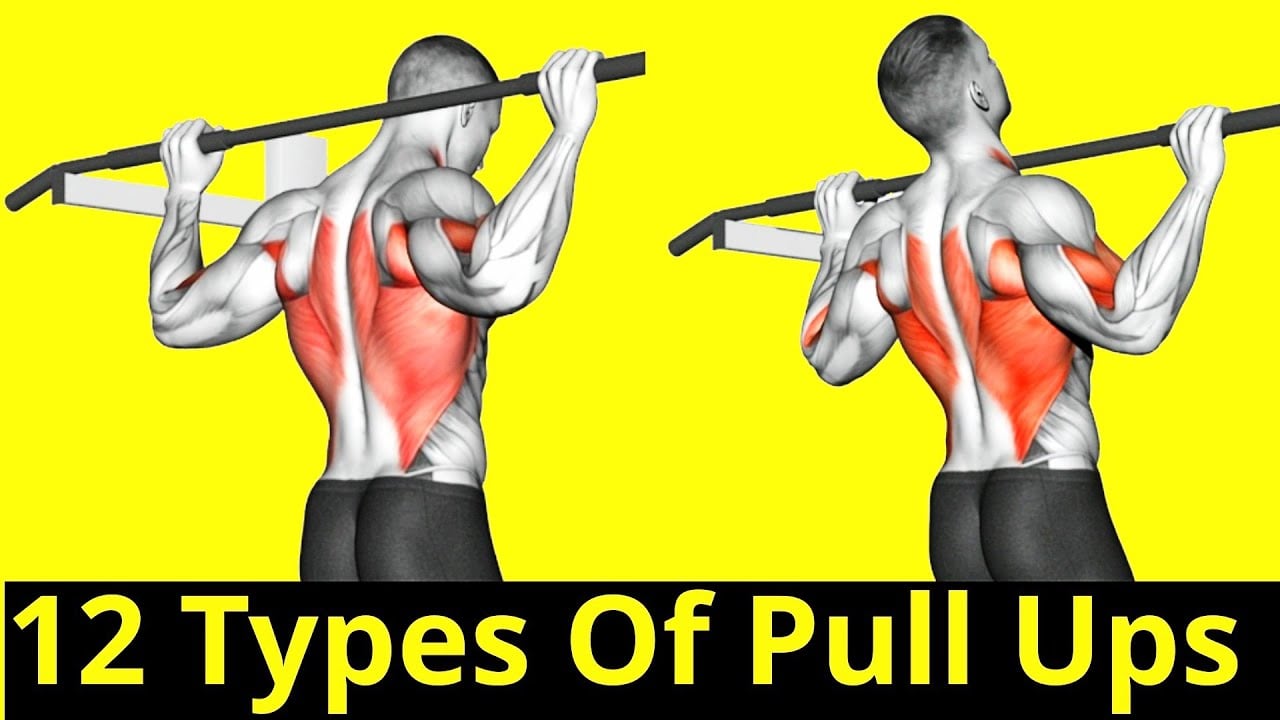Are you looking for a way to make your upper body workout more challenging? Look no further than pull-ups and chin-ups.
Pull-ups are an effective exercise to build strength and offer various variations to keep your back workout routine fresh and challenging.
Whether you’re a beginner or an advanced fitness enthusiast, pull-ups and chin-ups are a must-have in your exercise routine.
But we have many questions about pull-ups, which are confusing us.
Which type of push-up is good for a beginner, intermediate, and advanced person? And which one is the best for back and biceps
After reading this article, you will know about pull-ups and chin-ups.
- What are Pull-ups and chin-ups?
- Types of pull-ups and muscles worked.
- Different Types Of Pull And Chin-Up Grips
- Best Variations and Modifications
- Which types are the easiest, and which are the hardest?
- Which pull-ups and chin-ups are best for the back?
- What are the best Pull-ups for chest/bicep/tricep?

- What Are Pull-Ups and Chin-Ups?
- Why Different Types Of Pull-Ups and Chin Up Are Required
- 1. Target The Different Muscle Groups
- 2. Overcome Plateau
- 3. Improve Overall Strength
- 4. Offer Variety for all fitness levels.
- 5. Enhance your workout experience.
- Different Types Of Grips For Doing Pull-Up
- 1. Overhand grip
- 2. Underhand grip
- 3. Neutral grip
- 4. Mixed grip
- Muscle Worked During Pull-Ups
- Modifications And Variations For Pull-Ups and Chin-Ups
- Make It Easier
- Make It Harder
- Best Chin-Up And Pull Up Variations
- 1. Regular Chin Ups
- 2. Regular Pull Up
- 3. Machine Assisted Chin-Ups And Pull-Ups
- 4. Band Assisted Chin-Ups And Pull-Ups
- 5. Isometric Holds Pull-Ups and Chin Ups
- 6. Wide-Grip Pull-Ups
- 7. Close-Grip Pull-Ups
- 8. Neutral-Grip Pull-Ups/Chin Up
- 9. Mixed-Grip Pull-Ups And Chin Up
- 10. Weighted Pull-Ups And Chin Up
- 11. L-Sit Chin Up & Pull-Ups
- 12. Commando pull ups
- 13. Negatives Chin-Up And Pull-Ups
- 14. Side to side pull up
- 15. Clapping Pull-Ups
- 16. Behind-the-Neck Pull-Ups
- 17. Single-arm chin-up
- 18. Jumping pull-ups
- 19. scapular Pull ups
- 20. Towel Pull-ups/Chin-ups
- 21. V-Bar Pull Up
- 22. Rope pull-ups
- 23. Muscle-up
- 24. Chest-to-bar pull-ups
- 25. Plyometric Pull Ups
- No. Sets and Reps Pull-ups For Beginner To Advanced
- Different Types Of Pull-Ups (Beginner to Pro Variations)
- FAQs
- How Often Should I Do Pull-Ups?
- What is the best pull-up variation?
- What is the hardest pull-up to do?
- How many pull-ups are impressive?
- Are pull-ups harder for bigger guys?
- Can pullups grow biceps?
- What type of pull-ups work chest
- which type of pull up works triceps
- Takeaways
- References
What Are Pull-Ups and Chin-Ups?
Pull-ups and chin-ups are compound exercises, which means that they work multiple muscle groups at the same time.
They primarily target the upper body’s muscles, specifically the back, shoulders, arms and core muscles.
It is a great exercise for those who are looking to build upper body strength, improve posture, and increase muscle mass.
Both exercises are performed using an overhead bar, but the main difference between the two is the grip position.
- A pull-up is performed by gripping the bar with an overhand grip, with the palms facing away from the body. This grip targets the back and shoulders more than the biceps.
- A chin-up is performed by gripping the bar with an underhand grip, where the palms face the body. This grip targets the biceps more than the back and shoulders.
In both exercises, you start with your arms fully extended. Then, you pull your body up towards the bar until your chin is above it.
Know More: Pull-Ups Vs Chin-Ups: The Ultimate Comparison
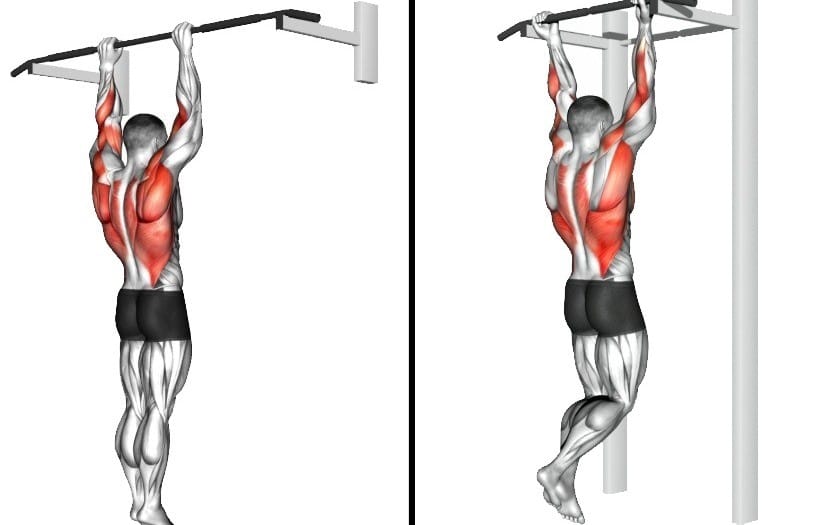
Why Different Types Of Pull-Ups and Chin Up Are Required
There are several reasons why different types of pull-ups and chin-ups are required.
1. Target The Different Muscle Groups
Changing the grip position and hand placement can target different muscle groups. For example,
- Traditional pull-ups focus on the lats, while close-grip pull-ups target the biceps.
- Similarly, traditional chin-ups focus on the biceps, while wide-grip chin-ups target the back muscles.
2. Overcome Plateau
The body adapts to the same exercises over time, so switching to different variations can keep the muscles challenged and continue to promote growth.
3. Improve Overall Strength
The different types of pull-ups and chin-ups can help to improve overall upper body strength and muscle balance.
This can help you achieve a more symmetrical physique.
4. Offer Variety for all fitness levels.
Each variation also offers a different difficulty level, allowing you to progress as you get stronger.
5. Enhance your workout experience.
Including different types of pull-ups in your workout routine can help to reduce boredom and make your workout more fun and enjoyable.
Different Types Of Grips For Doing Pull-Up
There are several different types of pull-up grips, including:
1. Overhand grip
This is also known as a pronated grip, which is the most common grip for pull-ups, with the palms facing away from the body. This grip targets the back muscles and biceps.
2. Underhand grip
It is also known as a supinated grip and is used for chin-ups with the palms facing towards the body. This grip targets the biceps and forearms more than the back muscles.
3. Neutral grip
This grip involves gripping the bar with your palms facing each other, which can reduce stress on the shoulders and wrists.
4. Mixed grip
It’s also known as an alternate grip, which involves using one hand in an overhand grip and the other hand in an underhand grip. This can help to increase grip strength and stability.
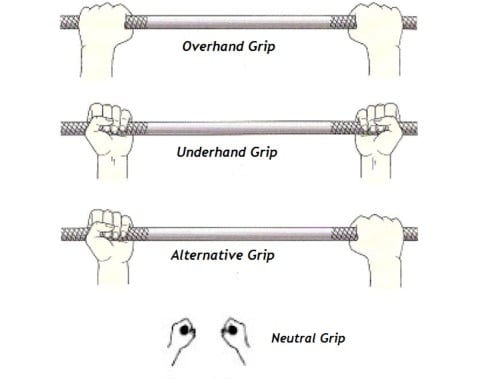
Muscle Worked During Pull-Ups
Pull-ups primarily work the back but also involve several other muscle groups in the upper body.
The main muscles worked during pull-ups are:
Synergists muscles worked:
- Biceps, brachialis, Brachioradialis
- Rear deltoid, rhomboids, Levator Scapulae, Trapezius muscle groups, Pectoralis Major, erector spinae, Infraspinatus
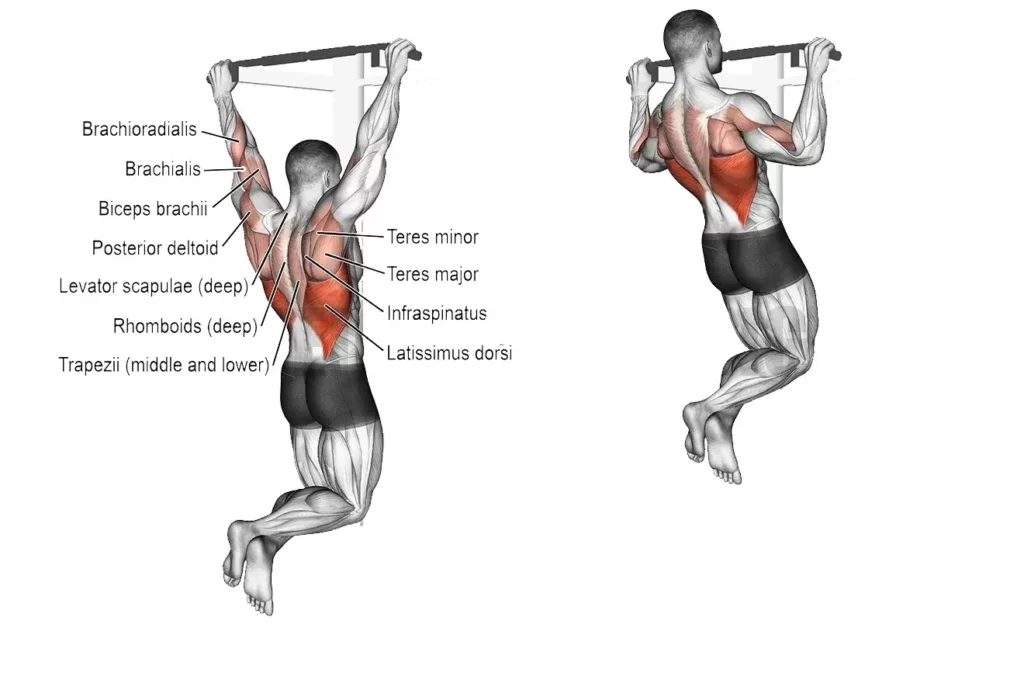
Pull-ups primarily work for the following muscle groups:
- The lats are the largest muscle in the back and are responsible for the “V-shape” appearance.
- The rhomboids are located in the upper back and pull the shoulder blades together.
- The trapezius is a large muscle that extends from the neck to the middle of the back and is responsible for moving the shoulders.
- The biceps muscle flexes the elbow and assists in pulling the body up towards the bar.
- Forearm muscles, brachioradialis and brachialis, also work during pull-ups to maintain grip strength and stability.
- The core muscles, including the rectus abdominis, transverse abdominis, and obliques, also work during pull-ups to maintain stability and balance.
Modifications And Variations For Pull-Ups and Chin-Ups
When you want to broaden the scope of your workouts without introducing new equipment or different training concepts. You can pack a few different types of pull-ups into one workout.
Many of these moves can be made easier or harder, depending on your requirements.
Make It Easier
Some modifications and variations can be made to make pull-ups and chin-ups easier.
- Machine-assisted pull-up: where weight is added to assist with the movement.
- Resistance-assisted Pull-ups: where the band provides support and helps to lift a portion of the body weight
- Isometric holds: hold yourself in the top position of the pull-up or chin-up for a certain amount of time before progressing to full reps.
- Use a box or bench to step up to the pull-up bar, which reduces bodyweight lifted.
Make It Harder
Some modifications and variations that can be made to make pull-ups and chin-ups harder include:
- Adding weight to the body, such as using a weight belt or holding a dumbbell between the legs
- Increasing the reps and sets.
- Push-ups with a wide grip increase the difficulty and emphasize forearms.
- Doing a one-arm pull-up or chin-up increases the difficulty and emphasizes the upper body.
- Incorporating dynamic movements such as plyometric pull-ups.
- Adding a pause at the top increases the time under tension and makes the exercise more challenging.
Best Chin-Up And Pull Up Variations
Once you’ve mastered the standard chin-up and pull-up, you can start doing more variations that match your strength goals.
Here are some great chin-up and pull-up variations to help you build strength, power, and muscle.
1. Regular Chin Ups
A chin-up is an exercise where the palms face toward the body (overhand or pronated grip) while gripping the bar.
This grip targets the biceps more than the back and shoulders.
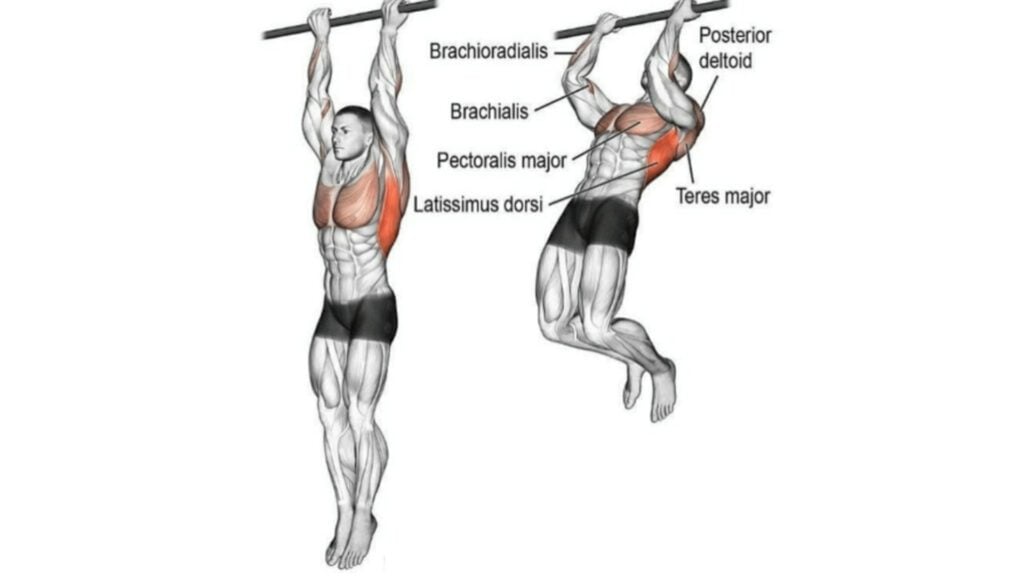
How To Do It
- Grip the pull-up bar with your palms facing toward you and use a narrow grip.
- Hang from the bar with your arms fully extended and shoulders pulled down and back.
- Engage your core and keep your body straight from your head to your heels.
- Pull your body up towards the bar by flexing your elbows and bringing your chest towards the bar.
- Keep your elbows close to your body as you pull yourself up.
- Once your chin is above the bar, hold for a moment and lower yourself slowly.
2. Regular Pull Up
A pull-up is an exercise where the palms face away from the body (underhand or supinated grip) while gripping the bar.
This grip targets the back and shoulders more than the biceps.

How To Do It
- Grip the pull-up bar with your palms facing away from you at shoulder width.
- Engage your core and keep your body straight from your head to your heels.
- Pull your body up towards the bar by flexing your elbows and bringing your chest towards the bar.
- Once your chin is above the bar, hold for a moment and lower yourself slowly.
3. Machine Assisted Chin-Ups And Pull-Ups
Machine-assisted chin-ups and pull-ups are exercises that are performed using a machine that assists you while you perform the exercise.
The machine allows the user to perform the exercise with less resistance, making it easier for them to complete a full range of motion.
This is especially helpful for beginners who need to build their strength gradually.
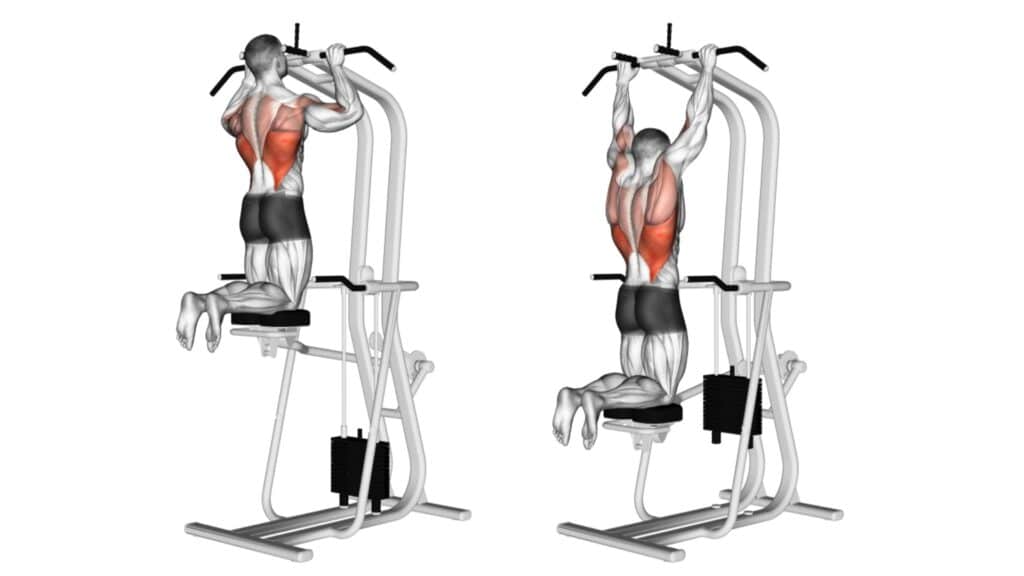
How To Do It
- Adjust the weight of the machine to your desired level.
- Grasp the bar with a grip that is slightly wider than shoulder-width.
- Take a step onto the footrests and position your body so that your knees are bent and your arms are straight.
- Begin the exercise by pulling your body upwards towards the bar.
- As you reach the bar, pause briefly and lower your body back down to the starting position.
4. Band Assisted Chin-Ups And Pull-Ups
Band-assisted chin-ups and pull-ups are variations that use a resistance band to assist in the exercise.
This variation can be helpful for beginners or those looking to increase the number of reps they can perform.
It can also be used as a way to progress towards unassisted chin-ups and pull-ups.
The amount of assistance can be adjusted by using a band with different resistances or by adjusting the band’s position.
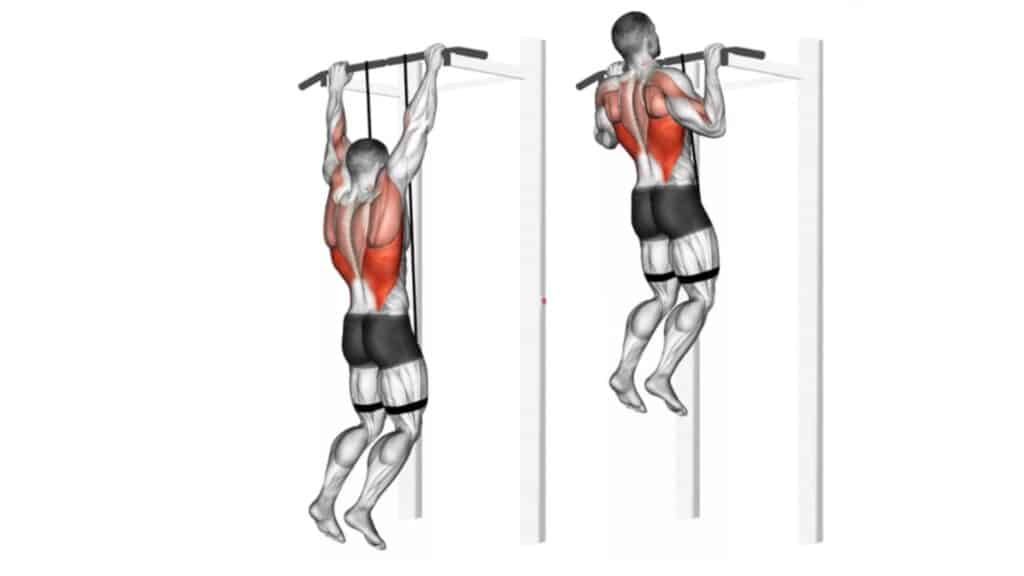
How To Do It
- Wrap the band around a pull-up bar and secure it in place by tying a knot.
- Stand on the floor below the bar and step into the band to support you under your feet.
- Grasp the pull-up bar with a grip that is slightly wider than shoulder-width.
- Pull yourself up towards the bar.
- Focus on using your back and arm muscles to pull your chin over the bar.
- Lower yourself down in a controlled manner.
5. Isometric Holds Pull-Ups and Chin Ups
Isometric holds involve holding yourself at the top or both positions for some time.
This type of exercise can help build strength and endurance in the muscles used for pull-ups and chin-ups and can also help improve your overall technique.
For example, you can perform an isometric hold at the top of a chin-up by pulling yourself up to the bar and holding the position for a set period of time, such as 5-10 sec.
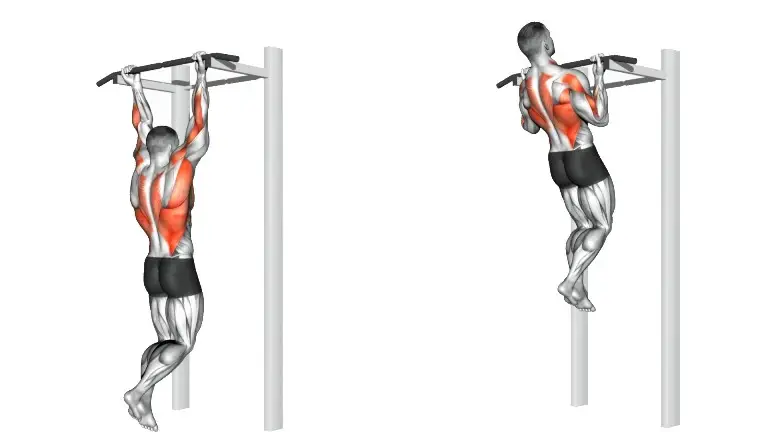
How To Do It
- Grab the pull-up bar with your palms facing you and your hands about shoulder-width apart.
- Pull yourself up until your chin is over the bar.
- If you cannot do a chin-up, you can still do this exercise by using a chair or step to jump.
- Make sure your chin is above the bar.
- Hold for 5 seconds, then lower down to 90 degrees and hold for 5, then lower down again to just before the bottom.
6. Wide-Grip Pull-Ups
During wide-grip pull-ups, the hands are positioned wider than shoulder-width apart on the bar.
This grip variation allows for a greater range of motion and increased muscle activation in the upper back and lats.
It can also help improve grip strength and work on the back muscles.

How To Do It
- Pick up a pull-up bar with your hands wider than shoulder-width apart.
- Hang from the bar with your arms fully extended and your chest high.
- You can pull yourself up by squeezing your shoulder blades together and contracting your lats until your chin is above the bar.
- Hold the contraction at the top for a second.
- Then, slowly lower yourself back to the starting position.
7. Close-Grip Pull-Ups
When performing Close grip pull-ups, the hands are placed closer than shoulder-width apart on the bar.
This grip variation increases the activation of the biceps and forearms and can help improve grip strength.
It’s important to use proper form and not to grip too close to avoid unnecessary stress on the wrist.
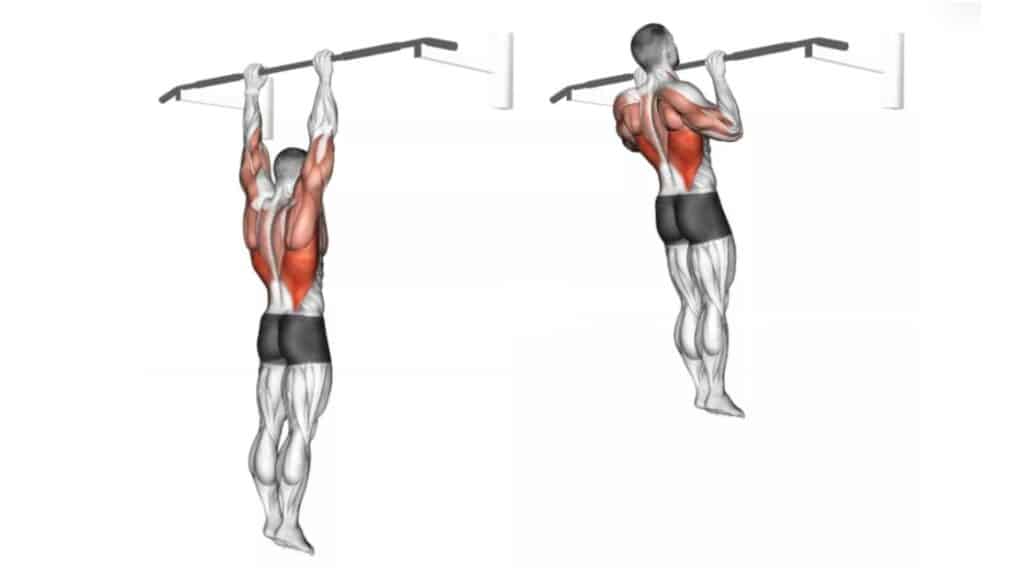
How To Do It
- Place your hands closer than shoulder-width apart.
- Engage your back muscles and pull your body up towards the bar.
- Keep your elbows close to your body, and avoid swinging or kicking your legs.
- Once your chin is over the bar, pause briefly and lower yourself back down to the starting position.
8. Neutral-Grip Pull-Ups/Chin Up
In neutral-grip pull-ups, the hands are positioned with a parallel grip (palms facing each other) on the bar or a parallel bar.
This grip variation puts less stress on the shoulder and also works on the biceps and forearms.
Neutral grip pull/chin-up variation can be useful for those with shoulder injuries or pain, as it can be less stressful on the shoulder joint.
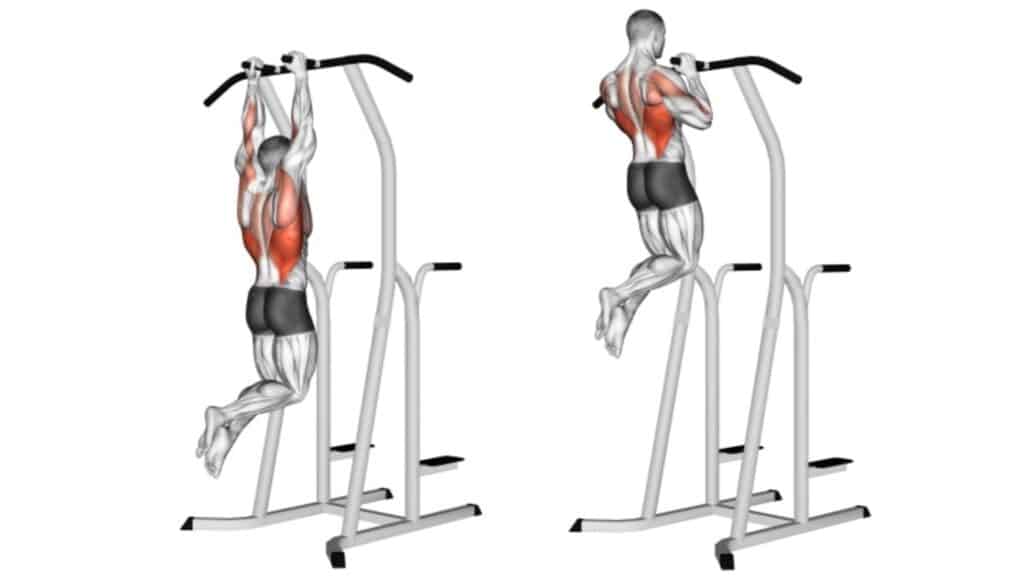
9. Mixed-Grip Pull-Ups And Chin Up
In this variation, one hand is positioned with an overhand grip (palms facing away from the body), and the other hand is positioned with an underhand grip (palms facing towards the body) on the bar.
However, due to the asymmetrical nature of the exercise, it can put extra stress on the shoulder.
It is important to be careful with the form and not to overdo it.
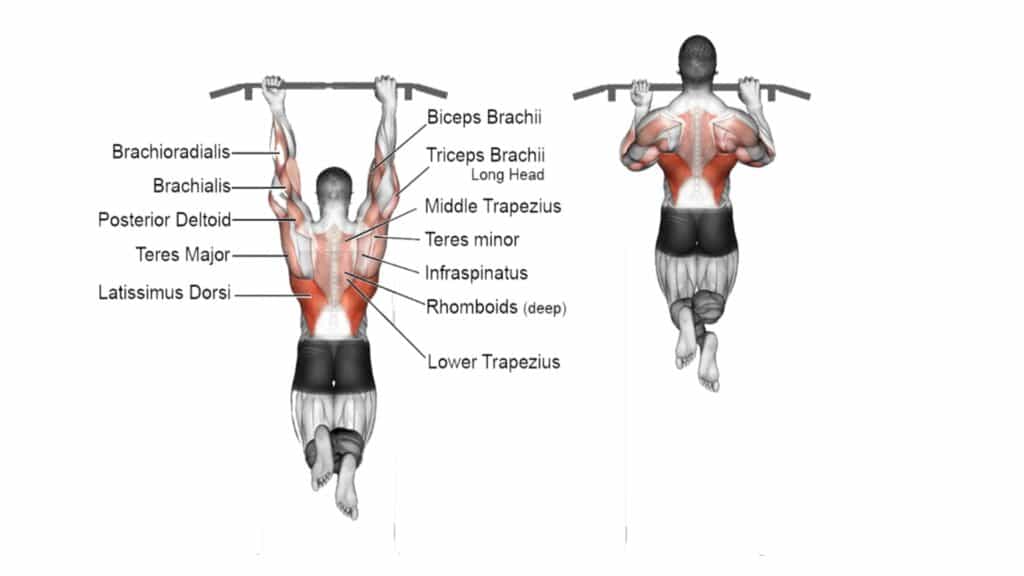
10. Weighted Pull-Ups And Chin Up
In weighted pull-ups and chin-ups, additional weight is added to the body during the pull-up, typically in the form of a weight belt or a dumbbell held between the legs.
The added weight increases the resistance and the difficulty of the exercise.
It’s a great way to progress from bodyweight pull-ups and chin-ups and to increase the intensity of the workout.
It’s also important to have a strong base of bodyweight pull-ups before attempting this variation.
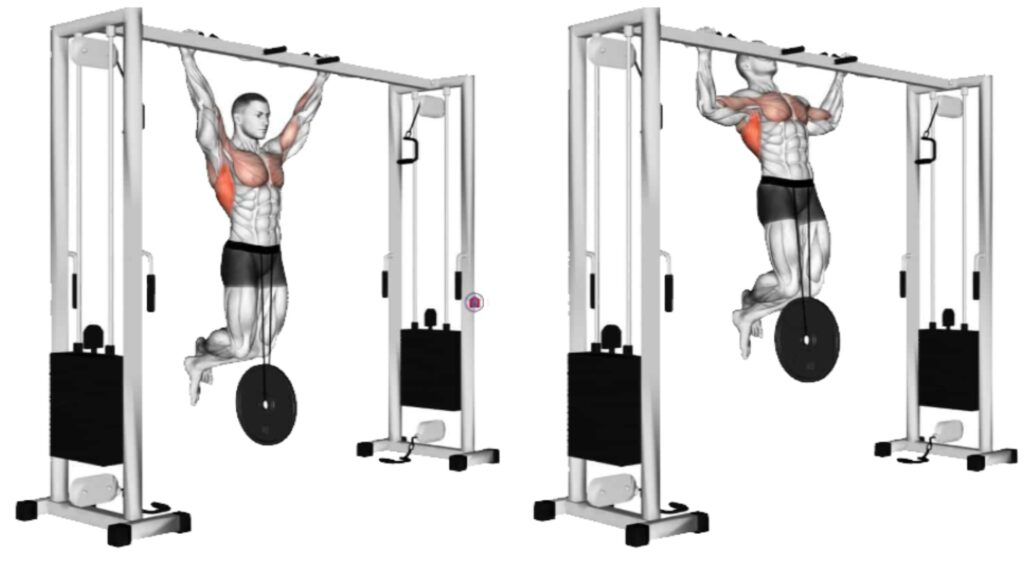
11. L-Sit Chin Up & Pull-Ups
In this variation, the individual performs a pull-up while maintaining an L-sit position (legs extended out in front of the body at a 90-degree angle).
It’s a challenging exercise that can help to increase core strength, stability, and upper body strength.
It’s also a great way to progress from traditional pull-ups and chin-ups.
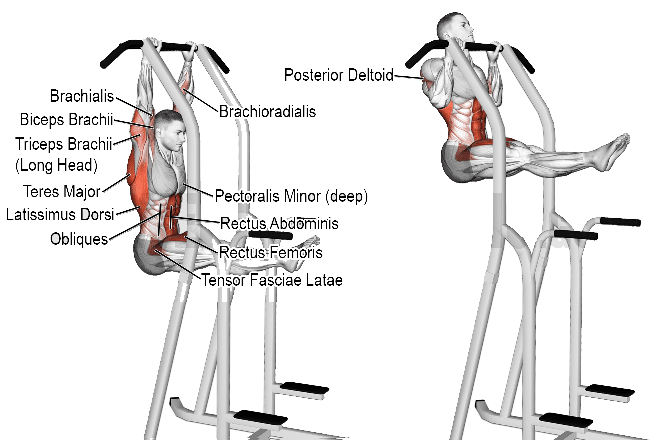
12. Commando pull ups
Commando pull-ups are similar to the close-grip chin-ups but with a more specific grip.
In this variation, the hands are positioned with a narrow grip, mimicking the grip of a hockey stick, with the palms facing away from the body.
It emphasizes more on the biceps and forearms than the back. It can also be a great way to improve grip strength and endurance.
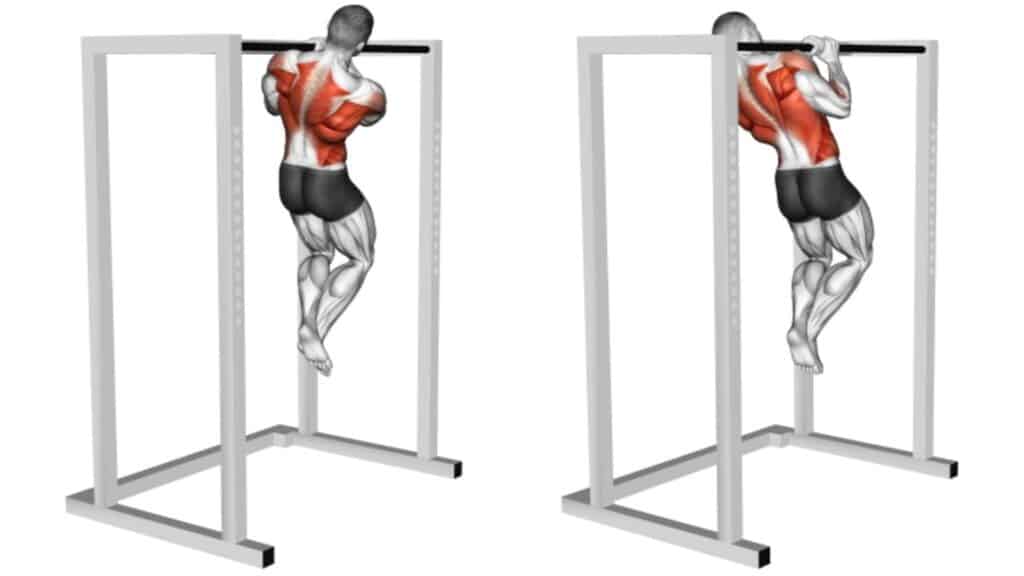
How To Do It
- Grip the bar with one hand facing forward and the other facing backward, about shoulder-width apart.
- Begin the exercise by pulling yourself up with the hand that is facing forward.
- Once your chin is above the bar, switch your grip so that the hand that was facing forward is now facing backward, and the hand that was facing backward is now facing forward.
- Lower yourself down to the starting position with your new grip.
- Repeat the exercise with the opposite hand leading.
13. Negatives Chin-Up And Pull-Ups
Negative Chin-ups, also known as “eccentric chin-ups, ” are a variation of chin-ups focusing on the movement’s eccentric (lowering) portion.
In this variation, the individual uses a step or a partner to help them jump or lift themselves to the top position of the chin-up or pull-up and then slowly lower themselves down over a period of several seconds.
This can greatly increase muscle activation and strength in the upper back, lats, and biceps.
Additionally, since the negative portion is slower, it creates more time under tension.
14. Side to side pull up
Side-to-side pull-ups, or archer Pull-Ups, are the advanced moves you must work on to more effectively target the upper back, lats, biceps, and core.
In this variation, the individual performs a pull-up while swinging their body from side to side.
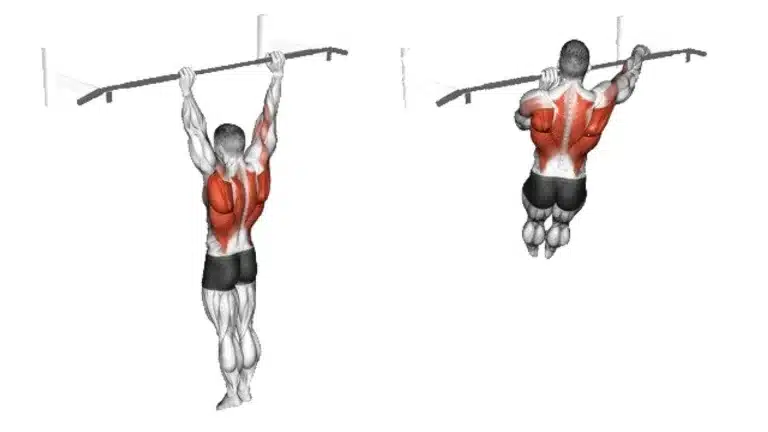
How To Do It
- Position yourself into a partial pull-up position on an elevated surface, with one arm wide and the other narrow.
- Keep your core engaged, and slowly draw each arm towards either side of your body.
- Focus on keeping your elbows close to your body and repeat for the desired number of repetitions.
15. Clapping Pull-Ups
Clapping pull-ups, also called explosive pull-ups, are a variation of pull-ups that emphasize power and explosiveness.
In this variation, the individual performs a pull-up and then quickly releases their hands from the bar, clapping them together before catching the bar again and lowering themselves down.
It requires a significant amount of power and control. It can help to increase power, explosiveness, and muscle activation in the upper body.
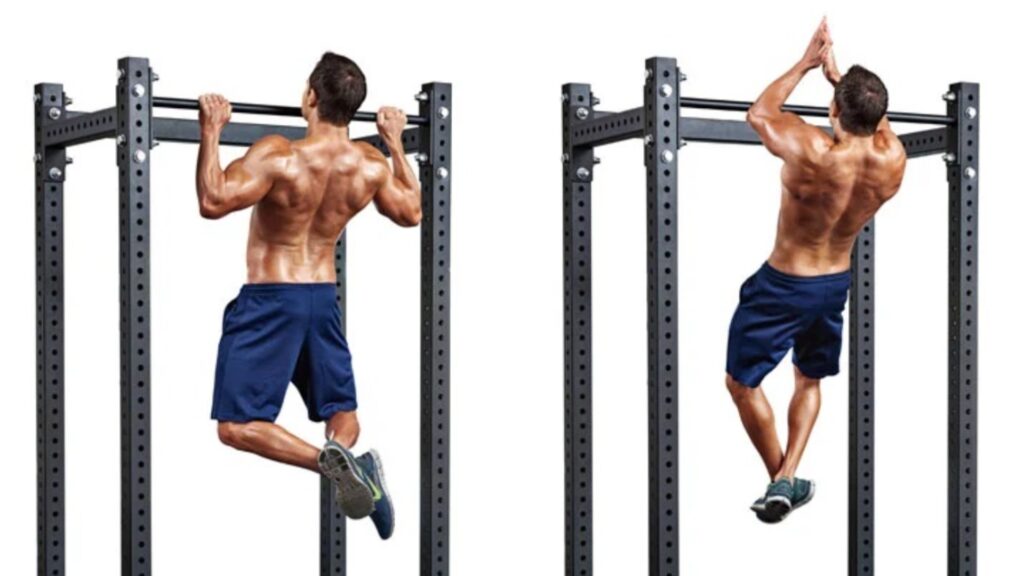
16. Behind-the-Neck Pull-Ups
Behind-the-neck or rear pull-ups are variations of your pull-up routine that can be added to prevent boredom and add intensity to your workout routine.
It requires a greater range of motion than a standard pull or chin-up, which is why it is often more challenging.
Pull yourself up slowly, touching your neck to the bar if possible.
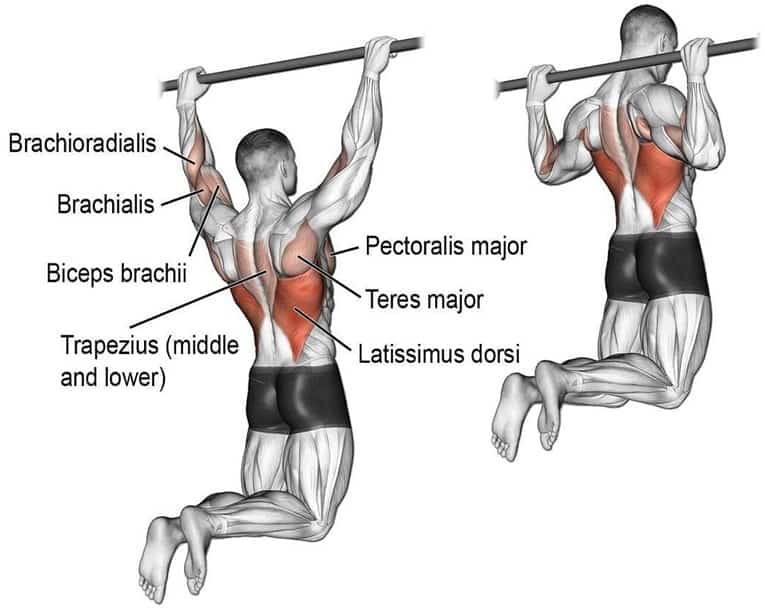
How To Do It
- Start by grasping the bar with an overhand that is wider than the shoulder width..
- To balance your body, bend your knees and cross your lower legs behind your body.
- Pull yourself up towards the bar and move your head underneath.
- When you feel your neck gently touching the bar, slowly lower yourself back down and repeat.
- When you lower yourself down, make sure you fully extend your arms..
17. Single-arm chin-up
A single-arm chin-up is a challenging variation of the traditional chin-up, which targets the same muscle groups but emphasizes grip strength and stability.
One-arm pull-ups and chin-ups are the best ways to show your physical and mental strength.
Grips the bar with one hand and performs the chin-up movement with that arm.
This variation can help to increase muscle activation and strength in the upper body, particularly in the forearm, biceps, and back.
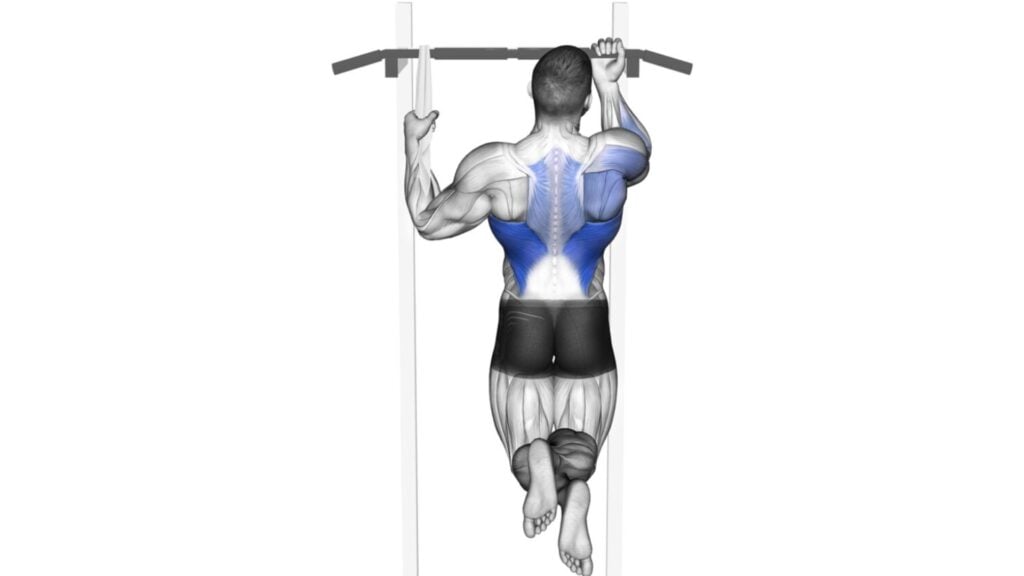
How To Do It
- Use a supinated grip to hold the bar with one hand and let your other arm hang free (or wrap around your wrist if needed).
- Hang from the bar with your arm fully extended. Your legs should be hanging straight down and your core should be tight.
- Use your back, biceps, and forearms to pull yourself up towards the bar until your chin is above the bar.
- Keep your elbow close to your body and your shoulder blades squeezed together.
- Lower yourself back to the starting position with control.
18. Jumping pull-ups
The jumping pull-up is good for people who want to condition their cardiovascular system, muscles, joints, and even their coordination movement pattern recruitment.
Jumping pull-up variations can help to increase power, explosiveness, and muscle activation.
It involves standing underneath a pull-up bar and then jumping up to grab it, using the momentum to assist with the pull-up movement.
It is a great way to work up to doing full pull-ups without the help of a spotter or any additional equipment.
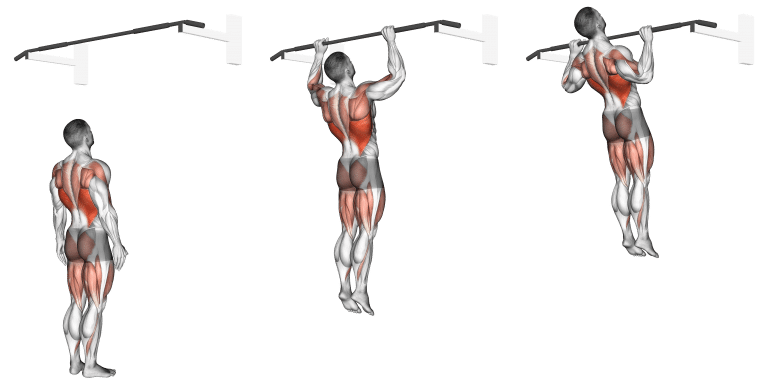
How To Do It
- Stand underneath a pull-up bar with your feet shoulder-width apart.
- Jump up and reach for the bar with both hands, using your momentum to help you reach the bar.
- Once you have a firm grip on the bar, use your arms and shoulders to pull your chest up towards the bar.
- Lower yourself back down to the starting position.
- Repeat the movement several times.
19. scapular Pull ups
Scapular pull-ups, also known as “scapular retraction pull-ups,” are a variation of pull-ups that focus on the scapular muscles and improve posture.
This movement is done without lifting the body; the shoulders are pulled up and down and the chin is tucked in.
The movement is primarily focused on the shoulder blade.
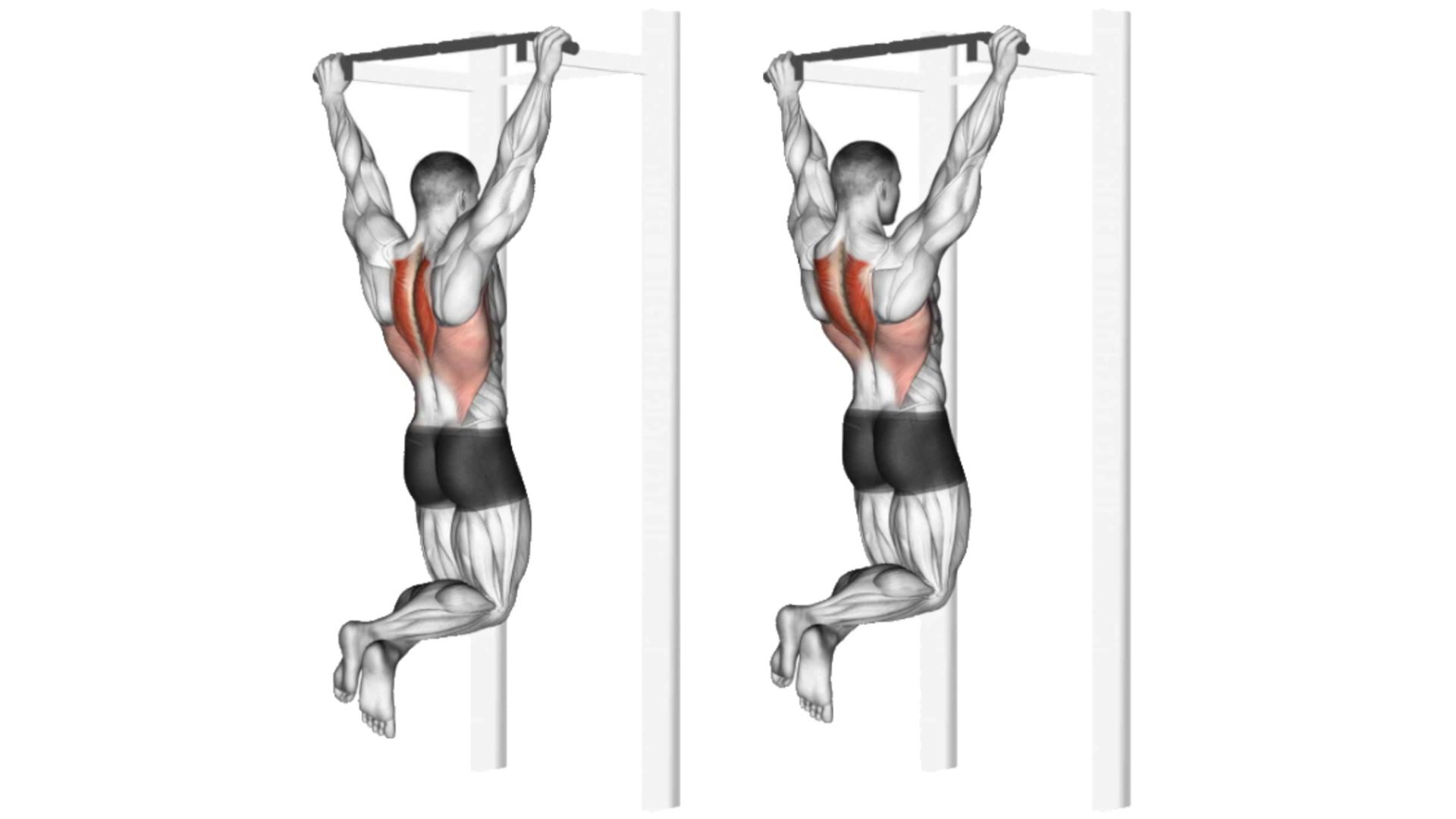
How To Do It
- Start with your normal pull-up position.
- Take a breath and initiate the scapular pull-up by bringing your shoulders back and down. Keep your arms straight.
- From a full hang, with just slightly shrugged shoulders, you want to draw the scapula down and together, thus raising your body slightly but without bending your arms and pulling as in a regular pull-up.
- Hold the retracted position for a second or two.
- Then, return to the starting position. The range of motion is only a few inches.
20. Towel Pull-ups/Chin-ups
The towel makes the exercise harder because it can be harder to grip and hold on to than a traditional pull-up bar.
Towel pull-ups help to increase muscle activation and strength in the upper body, especially in the biceps and back, as well as improve grip strength and endurance.
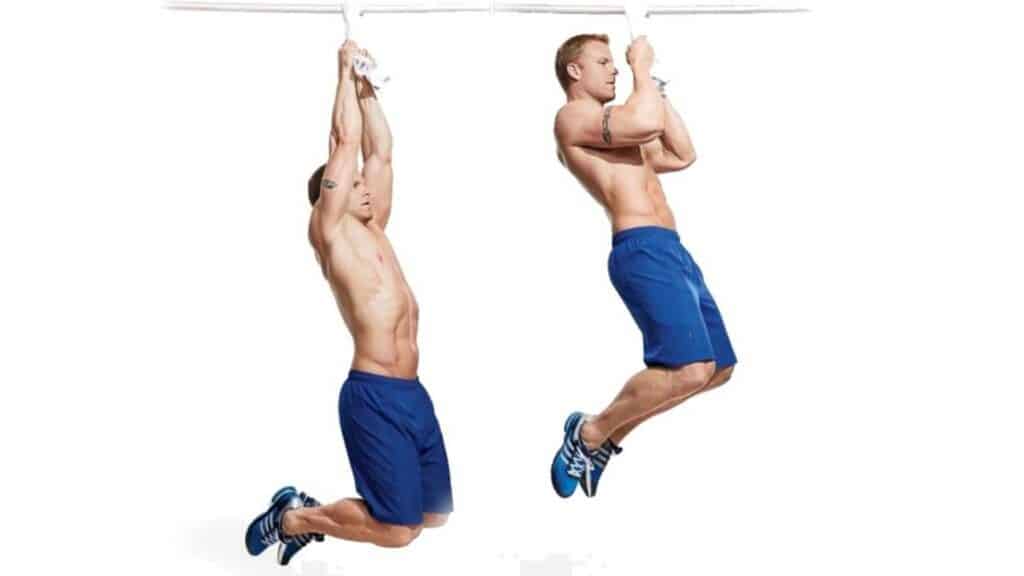
How To Do It
- Wraps a towel around a pull-up bar.
- Grips the towel with both hands.
- Use your arms and shoulders to pull your chest up towards the bar.
- Lower yourself back down to the starting position.
21. V-Bar Pull Up
V-bar pull-ups are performed using a pull-up bar with a V-shaped handle attachment.
This variation emphasizes the inner lats and the brachialis muscle, and less on the outer lats and the biceps. It also targets the forearms and grip strength.
This variation is great for working specific muscle groups and changing your pull-up routine.
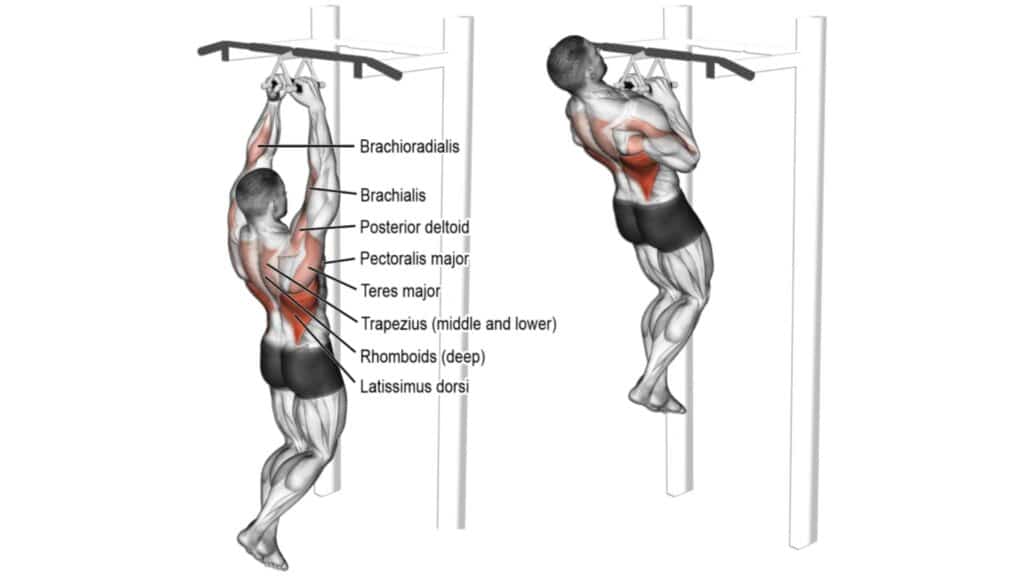
How To Do It
- Grab the V-shaped handles with an overhand grip.
- Hang from the bar with your arms fully extended and your shoulders relaxed.
- Pull yourself up towards the bar.
- Pull until your chin is above the bar.
- Slowly return to the starting position.
22. Rope pull-ups
Rope pull-ups are a variation of traditional pull-ups that involve gripping the bar with a rope.
It places more emphasis on the grip strength and forearms.
The rope provides an unstable surface to grip, which requires more control and stability in the upper body.
How To Do It
- Attach a thick rope to the bar, ensuring it’s securely fastened.
- Grip the rope with both hands, ensuring your hands are about shoulder-width apart.
- Pull yourself up towards the rope until your chin is above the bar.
- Slowly lower yourself to the starting position.
23. Muscle-up
The muscle-up is an advanced bodyweight exercise that combines a pull-up and a dip into one movement.
It requires significant upper body strength and skill to perform
It’s recommended that beginners start with simpler exercises like pull-ups and dips and gradually work their way up to the muscle-up.

How To Do It
- Hang from a pull-up bar with your palms facing away from you and your arms fully extended.
- Pull your body up towards the bar.
- Once your chest reaches the bar, lean forward slightly.
- Push yourself up and over the bar, straightening your arms and completing the dip portion of the movement.
- Lower yourself back down to the starting position.
24. Chest-to-bar pull-ups
Chest-to-bar pull-ups/chin-ups are a type of pull-up exercise with the goal of pulling your chest up to touch the bar.
This more challenging variation of the traditional pull-up requires more upper-body strength and control.
It emphasizes the upper body muscles, specifically the chest, shoulders, and lats.
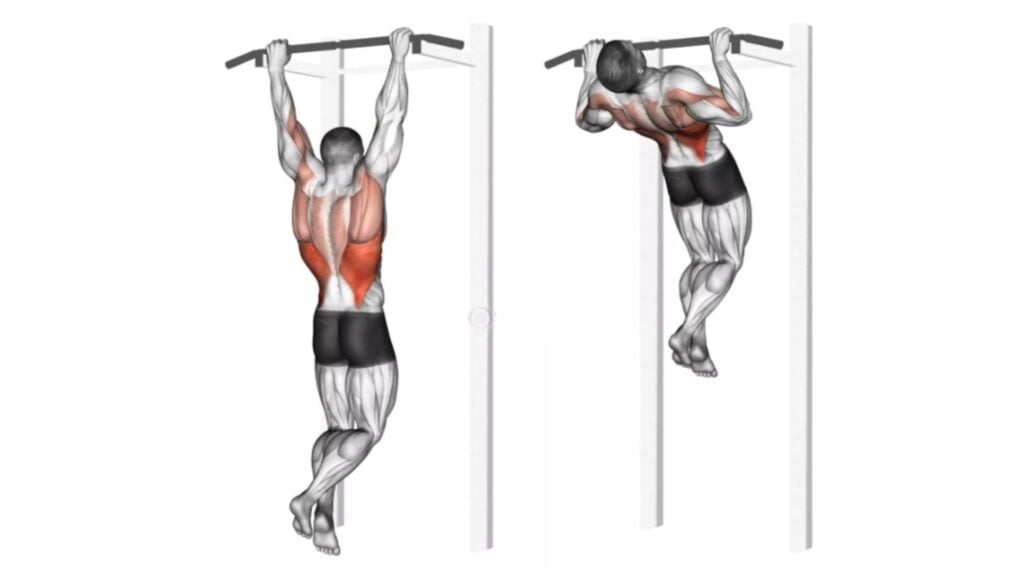
How To Do It
- Hang from a pull-up bar with your arms fully extended.
- Pull yourself up towards the bar by bending your elbows and pulling your chest towards the bar.
- Continue to pull until your chest touches the bar or comes very close to it.
- With control, lower yourself back down to the starting position.
25. Plyometric Pull Ups
Plyometric pull-ups add a plyometric (jump training) aspect to the exercise, which helps to increase power, explosiveness, and speed.
This exercise is advanced and requires a lot of upper body strength and control and the ability to generate power. It’s not recommended for beginners.
To perform this exercise, you start in a dead hang position, then explosively pull yourself up, and then jump up before returning to the dead hang position.
No. Sets and Reps Pull-ups For Beginner To Advanced
For beginners, it is important to start with an appropriate level of difficulty and progress slowly.
- Beginner: 3 sets of 8–10 reps of assisted pull-ups, with 30-60 seconds rest between sets.
- Intermediate: 3-4 sets of 6-8 reps of pull-ups, with 30-60 seconds rest between sets.
- Advanced: 4-5 sets of 8-12 reps of pull-ups, with 30-60 seconds rest between sets.
Including other upper body exercises, such as push-ups and rows, is also important in your workout routine.
As you progress, you can do more challenging versions of pull-ups, such as chin-ups.
Furthermore, you should increase the number of reps and sets and reduce the rest time.
It’s important to focus on progressive overload, which means increasing the resistance (weight, reps) over time.
Different Types Of Pull-Ups (Beginner to Pro Variations)
FAQs
How Often Should I Do Pull-Ups?
For beginners, it is recommended to perform pull-ups at least once or twice a week, with at least one day of rest in between.
As you build strength and stamina, you can gradually increase the frequency to three or four times a week.
What is the best pull-up variation?
There isn’t one “best” pull-up variation, depending on an individual’s fitness level, goals, and specific muscle group targeting needs.
Different variations, such as wide-grip pull-ups, narrow-grip chin-ups, chest-to-bar pull-ups, plyometric pull-ups, V-bar pull-ups, etc., target different muscle groups.
It’s always a good idea to include a variety of pull-up variations in your workout routine to target different muscle groups and for variety.
What is the hardest pull-up to do?
Muscle and arm pull-ups are considered the most challenging pull-up exercises, but the hardest variation can vary depending on an individual’s fitness level and goals.
These exercises require high upper-body strength, control, and skill.
How many pull-ups are impressive?
For most people, it is impressive to be able to perform more than 10–12 reps of pull-ups.
Although the number of pull-ups considered impressive can vary depending on the individual’s fitness level, muscle mass, and body weight.
Are pull-ups harder for bigger guys?
Pull-ups can be more challenging for bigger guys, as body weight can play a role in the difficulty of the exercise.
The more weight a person has to pull up, the harder the exercise is.
Muscle mass and strength also play a role in pull-ups, so a bigger person with more muscle mass may find pull-ups to be less challenging.
Can pullups grow biceps?
The pull-ups are a compound exercise that targets the lats and also involves the biceps.
Pull-ups can help build and tone the biceps muscles but won’t make them bigger.
If bicep growth is the goal, specific bicep exercises such as barbell curls, hammer curls, and chin-ups would be more effective.
What type of pull-ups work chest
Chest-to-bar pull-ups and wide grip pull-ups are the types of pull-ups that work the chest muscle.
Other variations that work the chest muscles include the neutral grip pull-up and chin-up.
which type of pull up works triceps
Pull-ups that work the triceps muscle are close-grip pull-ups.
The triceps muscles are recruited more strongly in this variation because it is performed with a closer-than-shoulder-width grip.
Other variations that work the triceps muscles include chin-up.
Takeaways
Pull-ups and chin-ups are great exercises for building upper body strength and muscle mass.
They are a compound exercise that simultaneously works for several muscle groups, including the lats, biceps, and shoulders.
It is important to start with an appropriate difficulty level and then progress gradually, using modifications and variations as needed.
Incorporating different types of pull-ups and chin-ups can help target different muscle groups and provide a well-rounded workout.
Including other upper body exercises in your workout routine is also important for a balanced and well-rounded workout.
Consistency and progressive overload are important in achieving your pull-up goals.
References
- Hewit JK, Jaffe DA, Crowder T. A comparison of muscle activation during the pull-up and three alternative pulling exercises. J. Phys. Fitness, Med. Treat. Sport. 2018;5(4):1-7.
- Leslie KL, Comfort P. The effect of grip width and hand orientation on muscle activity during pull-ups and the lat pull-down. Strength & Conditioning Journal. 2013 Feb 1;35(1):75-8.
- Lusk SJ, Hale BD, Russell DM. Grip width and forearm orientation effects on muscle activity during the lat pull-down. The Journal of Strength & Conditioning Research. 2010 Jul 1;24(7):1895-900.
- Azmi AM, Shafiee MS, Abd Malek NF, Tan K, Vasanthi RK, Ab Malik Z, Nadzalan AM. The effects of knee flexion on muscle activation and performance during chin-up exercise. Pedagogy of Physical Culture and Sports. 2022;26(3):158-64.

Manish is a NASM-certified fitness and nutrition coach with over 10 years of experience in weight lifting and fat loss fitness coaching. He specializes in gym-based training and has a lot of knowledge about exercise, lifting technique, biomechanics, and more.
Through “Fit Life Regime,” he generously shares the insights he’s gained over a decade in the field. His goal is to equip others with the knowledge to start their own fitness journey.

